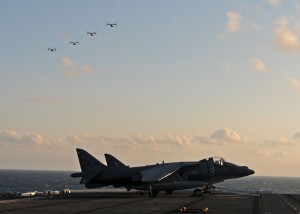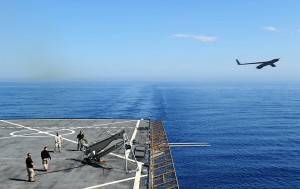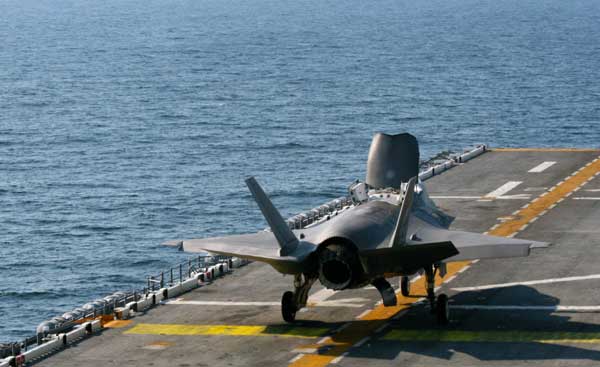5/26/12: In a follow-up interview with Col Brad Weisz, Deputy Commander Expeditionary Strike Group TWO, we talked about the evolution of the ARG-MEU as seen from the ESG perspective.
(To remind our non-USN and USMC readers, and ARG-MEU is the term used by the USN-USMC team to describe a core capability. This capability is built around a three ship group, and includes the Amphibious Ready Group (of those three ships and associated equipment) and the onboard USMC contingent which is called a Marine Expeditionary Unit. The MEU is normally built around a combat strength of 2,200 soldiers and usually commanded by a Colonel. It is empowered by several key aviation elements, and the force is built around a MAGTF and is composed of an aviation combat element (ACE) and a ground combat element, a battalion sized logistics element and a command element.)
The discussion harvested some of the lessons learned in BOLD ALLIGATOR 2012 (BA 12), but focused primarily on the evolution of the ARG-MEU and the capabilities of the force when the new aviation assets have been added over the decade ahead.
The ARG-MEU is a very flexible force.
But its inherent flexibility to operate over the spectrum of warfare is well suited to evolving 21st century missions.
Presence is a core element for shaping global security; via presence, domain knowledge for specific situations is developed or what the Marines call “habitual” experience.
The global engagement of the ARG-MEU force in the Pacific Rim, South America and the Middle East provides the USN-USMC team with a baseline engagement capability, which can meet the tasks by itself or reach back to other key elements, air, and ground or naval.
In a period in history where leaders are looking for cost effective engagement, the ARG-MEU is a bargain. The ARG-MEU and its modernization is a value proposition.
And the bargain will get even better.

In the decade ahead, the transformational Osprey will be joined by the F-35 Bravo and the CH-53K.
The Bravo brings a capability to conduct Tron warfare (electronic warfare, cyber ops, etc) and Situational Awareness to the ARG-MEU which hitherto was only available from land-based air or provided by large deck carriers.
With the CH-53K, three times the lift at significantly reduced maintenance costs are on offer to support the projection of power.
Col Weisz provided his perspective on these developments and the evolution of the ARG-MEU.
The BOLD ALLIGATOR Exercise highlighted the need to build upon current capabilities and to expand C5ISR throughout the deployed seabase as well as to do a better job over time integrating each core element, including MSC ships with the amphibious ships.
And we will need to evolve the C5ISR capabilities within the large deck amphibious ships as well to manage the new aviation assets.
A key element of change is clearly the introduction of the F-35 Bravo.
Col Weisz emphasized that we already saw some of what is coming in BA 12.
The combat systems aboard the BAC1-11 were F-35 combat systems. But they performed more like a USN E-2D Hawkeye (airborne C2 aircraft) than acting like a traditional tactical fighter.
And when the F-35 Bravos replace the AV-8B Harriers, there will be a significant enhancement in the C5ISR capability available to the ARG-MEU.
Col Weisz emphasized as well that the incorporation of the Bravo into the ARG-MEU would allow for a transition in the role and use of the large deck carrier.
In BOLD ALLIGATOR, the large deck carrier performed the initial shaping functions to allow the amphibious force (Amphibious Task Force and Landing Force) to enter and operate inside the littoral battlespace. It played a critical shaping function to ensure air and maritime superiority were achieved prior to our arrival on the scene.
I believe this was the first time in over a decade that the large deck carrier was part of an amphibious exercise. Exercise PURPLE STAR in the mid-to-late 1990’s was the last time a Carrier Strike Group was effectively integrated into an amphibious exercise.
The ENTERPRISE Carrier Strike Group engaged in a number of shaping, supporting and pre-assault operations for the amphibious force. Before we actually arrived on station in the amphibious objective area, the carrier strike group was out there was shaping the battle space for us, taking a good hard look at the anti-access/area denial environment.
When we finally arrived into the amphibious objective area, we utilized the MEB’s AV-8B Harriers and F/A-18 Hornets to support the ship-to-shore movement for the Marines, French and other Coalition forces going ashore. The habitual relationships that had been established through months of regular training events worked as advertised, superbly.
But with the Bravo and Osprey combination, the large deck carrier can transition to other roles.
With the Bravo, the amphibious fleet will have capabilities that today can only be found aboard the large deck carrier. This will free up the carrier to be used elsewhere and to operate differently itself.
(As an aside, Second Line of Defense will be looking at the role of the new Gerald Ford class of large deck carriers which feature significant new capabilities over the Nimitz class which when coupled with the new ARG-MEU capabilities can form a new approach to combat operations from the deployed and distributed fleet.)
Col Weisz underscored the current flexibility and versatility of the ARG-MEU Team and its centrality to the types of missions and operations, which characterize the period ahead. He underscored the ability of the ARG-MEU to operate across the spectrum of operations from theater security cooperation events to HA/DR missions to combat operations and its inherent scalability in doing so.
When you look at what the KEARSARGE ARG/24th MEU did last year, where they started off supporting a Humanitarian Assistance/Disaster Relief mission in Pakistan with CH-53Es; flying AV-8Bs Harriers off the Big Deck Amphib (USS KEARSARGE) directly into Afghanistan; where they went and conducted theater security cooperation events with countries like Kuwait, Saudi Arabia, Bahrain, Qatar, United Arab Emirates and Oman; their flexibility and versatility is truly amazing.
They then went into the Red Sea and performed several counter piracy operations; finished there, headed north and transited through the Suez Canal and prepared to conduct a potential non-combatant evacuation mission in the eastern Mediterranean that never took place.
Then they thought they’re going to have to support something in Tunisia. Well that didn’t place.
Then Egypt erupted and they rapidly planned for it. Finally they were given the go ahead for combat operations in Libya and executed brilliantly. Just to describe the environment and their engagement in that environment underscores the whole flexibility of the force.
SLD: In effect, one could coin a phrase and call this engagement flexibility or flexibility for engagement if you wish.
Col Weisz: And going forward the ARG-MEU will be much more capable as these new platforms and systems are introduced.
I definitely see the ARG-MEU of the future doing more distributed operations.
I won’t use the term — disaggregated operations, but I see them doing a lot more distributed operations. I believe the ARG-MEU Team will stay with the three-ship construct, but will more effectively distribute their blue-green force.
They will shape and mold more of their operations from the battalion landing team focus to company landing team operations and possibly even smaller as they support more of the distributed operations, everything from potential NEOs to TRAPs to HA/DRs to Embassy Reinforcement to Maritime Interdiction Operations where you’re going after pirates to finally theater security cooperation events.

SLD: You have emphasized the importance of beefing up the ISR and C2 capabilities of the ARG-MEU in our discussions. Obviously, the Bravo will be a key part of that.
But what role will unmanned systems play in the future?
Col Weisz: The key enablers are the manned airborne platforms, the Ospreys, the Bravos and the Ks. And the opportunity to better link and connect these assets with an upgraded capability aboard the ships is central as well. It also allows the ARG-MEU team to expand missions by enhancing what the manned systems can do. And when systems like Scan Eagle are tied into the Bravo, you will have much greater ISR coverage and task management generated by the manned asset.
Unmanned systems will play an enhancement role; not a replacement one. We are deploying right now the Scan Eagle on some of our amphibious ships. We use them to provide a lot of close-in ISR to the amphib ships as you go through some serious choke points, and some critical areas where they give you some extra SA so you don’t always have to use your manned assets for that task.
But let’s face it, when you get in the high intensity, high tempo operations, you want that manned aircraft out there providing the support. That has been my experience.


